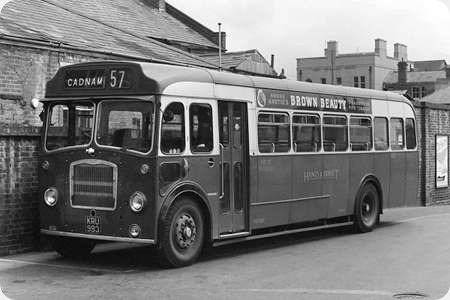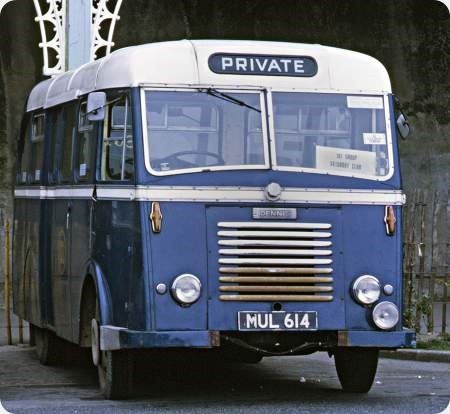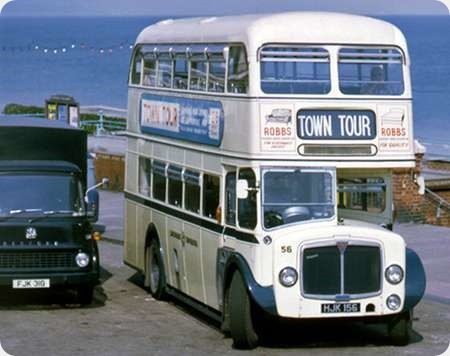
Hants & Dorset Motor Services
1952
Bristol LL5G
ECW FC37F
KRU 993 came to Hants & Dorset in February 1952 as a standard half cab LL6B with an ECW B39R body, one of a batch of seven similar vehicles, KRU 988-994, fleet nos. 782-788, delivered between September 1951 and February 1952. In June 1955 the Bristol AVW engine in KRU 993 was replaced by a Gardner 5LW, making the vehicle an LL5G, a conversion that had happened surprisingly earlier in October 1952 to KRU 990, and to KRU 991 in February 1953. It would seem that the other four retained their Bristol engines. Between September 1959 and July 1960 six of these buses were rebuilt by the operator to full fronted FB39F configuration for OPO operation, with KRU 992 being the last to be so treated in January 1962, but this had the lesser capacity of FB37F. All the others had their seating reduced to 37 in the years 1961 to 1966. The frontal treatment of the conversions ranged considerably from the plain appearance illustrated by KRU 993 through a variety of front panel designs, some bearing the more flamboyant ECW ‘coach’ style radiator grille. KRU 993 is pictured in Southampton in 1962 when it was still a 39 seater, the reduction by two seats occurring in November 1964. 787 was was the first of the batch to be withdrawn in January 1967 when it passed to a dealer. The rest were sold out of service in the following year. I acknowledge the //www.bristolsu.co.uk and the Local Transport History Library websites as sources for much of this history.
Photograph and Copy contributed by Roger Cox
03/05/21 – 07:11
I assume the motive behind these engine swaps was to obtain 6-cylinder units for use in 5LW-engined K-types. The problem which BT&CC and presumably H&D found with the arrival of the KSWs with their higher power was that where older lower powered vehicles were mixed in with them they had difficulty keeping to time – hence taking 6-cylinder engines out of single deckers to use in the double deckers.
Various other interesting features on H&D 787; the kerb view window similar to the SC type, the usual H&D sun-visor. This would also have had the pedestal type drivers seat with a catch released by a foot pedal allowing the seat to rotate so the driver could face the passengers to issue tickets. I always wondered about the safety aspects of these; what was to stop the seat going walkabout while on the move if it failed to catch when returned to the driving position?
Peter Cook
29/05/21 – 07:39
Far better looking than the leering toothy-grin radiator grille that marred so many other L rebuilds.
Ian Thompson

London County Council
1952
Dennis Triton TV3
Dennis B21C
The Dennis company during its independent days was ever prepared to meet specialist needs in the passenger, municipal and haulage transport fields. The Dennis Triton was a flat framed, small passenger chassis, seemingly a variant of the Pax municipal type, with a wheelbase of 10ft 6ins, though a 9ft 6ins wheelbase version was also available for van bodywork. The engine was the dependable 3.77 litre side valve petrol that had appeared in the 1933 40/45 cwt goods chassis and the contemporary Ace bus. This drove through a wet clutch into a four speed sliding mesh gearbox. The hydraulic brakes were non assisted. From 1952/3 the London County Council operated a fleet of 72 Triton TV3 buses with Dennis bodywork for 21 children with central passenger doors on both nearside and offside to facilitate access. A further two had special 12 seat bodywork with a tail lift to cater for the requirements of disabled children. Only one other Triton was built, which carried a Reading 12 seat body for Jersey Motor Transport in 1953, bringing the production total to 75. This little bus featured on a Jersey postage stamp, as seen here – the 1963 date is an error:- www.pinterest.co.uk/pin/
Ex LCC Triton MUL 614 is seen at Brighton on the occasion of the 1966 HCVC Rally, by then in the ownership of one of the National Saturday Clubs. Perhaps unsurprisingly, given its rather neglected state on that occasion, no present record of this bus seems to exist, nor, sadly, that of any other Triton.
Photograph and Copy contributed by Roger Cox

Eastbourne Corporation
1961
AEC Regent V 2D3RV
East Lancashire H32/28R
Having been a satisfied user of the AEC Regent III in its 9613A crash gearbox form, in 1956 Eastbourne Corporation turned to the Regent V D3RV with the dry liner A218 9.6 litre engine, synchromesh gearbox and vacuum brakes. DHC 649-655 had H30/26R bodies from the Corporation’s long favoured supplier, East Lancashire Coachbuilders, but these bodies were equipped with Auster window ventilation throughout. The next Eastbourne Regent V deliveries were of the 30 ft 2D3RV version, now with the wet liner AV590 engine. HJK 156-160 were fitted with East Lancs H32/28R bodies, and again had Auster window vents. The first of this batch, HJK 156, fleet number 56, is seen at the entrance to Eastbourne pier, and the impeccable standard of presentation of the bus ten years after its 1961 delivery is of great credit to the Corporation. This batch of five Regent Vs was withdrawn between 1978 and 1981, No.56 surviving to the end after some twenty years of service.
Photograph and Copy contributed by Roger Cox
28/03/21 – 17:25
Are you sure it was 30′ long? I had thought that all of Eastbourne’s Regent Vs were of the shorter variety; and the seating capacity would tend to support that assumption. Southampton also had short Regent Vs with East Lancs bodies (numbered 343-372), and these seated 66; so the Eastbourne vehicles would have provided very generous leg room if they were 30′ long!
Is the location correct – Bournemouth Pier? The adjacent vehicle also appears to have an Eastbourne registration.
Nigel Frampton
29/03/21 – 07:39
The Eastbourne Regent V’s were all 27ft long. The ‘2’ in the designation means a later model of the D3RV not necessarily 30ft long.
Philip Halstead
30/03/21 – 05:26
My mistake. I stand corrected; thank you gentlemen.
Roger Cox
30/03/21 – 05:27
I can certainly confirm that the setting of the photo is Eastbourne Pier which was the starting point of the Town Tour.
As Philip says all Eastbourne’s Regent V’s were 27ft long as for the designation the number 3 indicates that they were synchromesh manual gearboxes, if the designation had a 2 in that position they would have been the semi automatic Monocontrol gearbox. The 2 in the 2D3RV indicates the later AV590 engine and other changes to update the model, the R indicates right hand drive and the V vacuum brakes.
David Lennard



